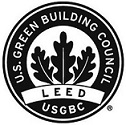LEED
Criteria
The LEED evaluation takes into account energy and ecological criteria and aims to standardise the field of sustainable construction. LEED enables building quality to be proved through certificates. So far, administrative buildings and the non-profit sector dominate the market with approximately 75% of all LEED registered projects. There are different rating schemes for different building categories, e.g. large or small-volume residential buildings (new construction/renovation), schools, sales outlets, health facilities, urban development, etc.
The following categories are used as a basis for assessment:
- Sustainable Sites
- Water Efficiency
- Energy and Atmosphere
- Materials and Resources
- Indoor Environmental Quality
- Innovation in Design or Operation
- Regional Priority
What are the ratings?
There are four rating levels: Certified, Silver, Gold, Platinum. For LEED certification, the minimum requirements must be met and a certain number of points must be achieved. Of the maximum 110 points, the Certified rating requires 40 points; Silver 50 points; Gold 60 points; and Platinum 80 points.


